
The secretarybird or secretary bird is a large, mostly terrestrial bird of prey. Endemic to Africa, it is usually found in the open grasslands and savanna of the sub-Saharan region. John Frederick Miller described the species in 1779. A member of the order Accipitriformes, which also includes many other diurnal birds of prey such as eagles, hawks, kites, vultures, and harriers, it is placed in its own family, Sagittariidae.

The Moorea Sandpiper is an extinct member of the large wader family Scolopacidae that was endemic to Mo'orea in French Polynesia, where the locals called it te-te in the Tahitian language.

The green wood hoopoe is a large, up to 44 cm (17 in) long tropical bird native to Africa. It is a member of the family Phoeniculidae, the wood hoopoes, and was formerly known as the red-billed wood hoopoe.
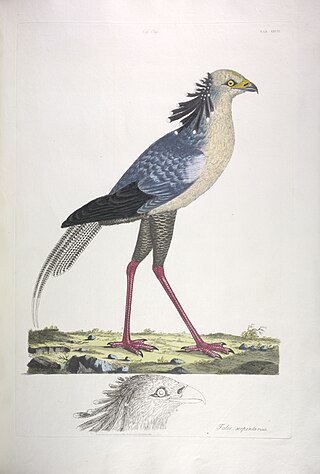
John Frederick Miller was an English illustrator, mainly of botanical subjects.
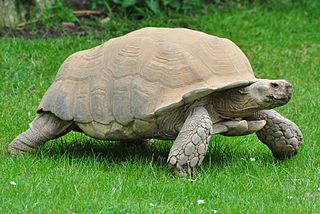
The African spurred tortoise, also called the sulcata tortoise, is an endangered species of tortoise inhabiting the southern edge of the Sahara Desert, the Sahel, in Africa. It is the largest mainland species of tortoise in the world, and the third-largest in the world, after the Galapagos tortoise and Aldabra giant tortoise. It is the only living species in its genus, Centrochelys, with the five other species in the family already extinct.
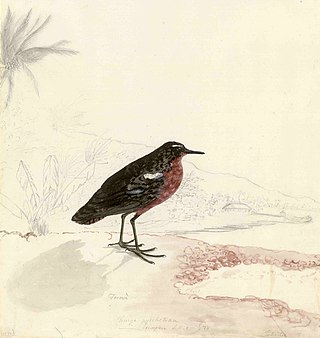
The Tahiti Sandpiper or Tahitian Sandpiper is an extinct member of the large wader family Scolopacidae that was endemic to Tahiti in French Polynesia until its extinction sometime before 1819.

The collared aracari or collared araçari is a near-passerine bird in the toucan family Ramphastidae. It is found from Mexico to Colombia and Venezuela.

The lesser florican, also known as the likh or kharmore, is the smallest in the bustard family and the only member of the genus Sypheotides. It is endemic to the Indian Subcontinent where it is found in tall grasslands and is best known for the leaping breeding displays made by the males during the monsoon season. The male has a contrasting black and white breeding plumage and distinctive elongated head feathers that extend behind the neck. These bustards are found mainly in northwestern and central India during the summer but are found more widely distributed across India in winter. The species is highly endangered and has been extirpated in some parts of its range such as Pakistan. It is threatened both by hunting and habitat degradation. The only similar species is the Bengal florican which is larger and lacks the white throat, collar and elongated plumes.

The Norfolk kākā is an extinct species of large parrot, belonging to the parrot family Nestoridae. The birds were about 38 cm long, with mostly olive-brown upperparts, reddish-orange cheeks and throat, straw-coloured breast, thighs, rump and lower abdomen dark orange and a prominent beak. It inhabited the rocks and treetops of Norfolk Island and adjacent Phillip Island. It was a relative of the New Zealand kākā.

The Tanna ground dove, also known as Forster's dove of Tanna, is an extinct dove species. Its taxonomic affiliation is uncertain but at its first scientific discussion by Johann Georg Wagler in 1829 it was classified into the genus Gallicolumba ; its closest relative is possibly the Santa Cruz ground dove. It was endemic to the Pacific island of Tanna, Vanuatu. Forster records a native name mahk, almost certainly from the Kwamera language.

The Tahiti rail, Tahitian red-billed rail, or Pacific red-billed rail is an extinct species of rail that lived on Tahiti. It was first recorded during James Cook's second voyage around the world (1772–1775), on which it was illustrated by Georg Forster and described by Johann Reinhold Forster. No specimens have been preserved. As well as the documentation by the Forsters, there have been claims that the bird also existed on the nearby island of Mehetia. The Tahiti rail appears to have been closely related to, and perhaps derived from, the buff-banded rail, and has also been historically confused with the Tongan subspecies of that bird.
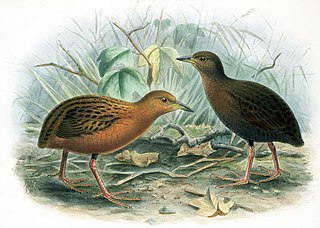
The Hawaiian rail, Hawaiian spotted rail, or Hawaiian crake is an extinct species of diminutive rail that lived on Big Island of Hawaiʻi.

The African rail is a small wetland bird of the rail family that is found in eastern and southern Africa.

The crested caracara is a bird of prey in the family Falconidae. It is found throughout Central and South America but has been found in northern Minnesota to Tierra del Fuego. It was formerly placed in the genus Polyborus.

Vini is a genus of birds in the family Psittaculidae that are endemic to the islands of the tropical Pacific. There are eleven extant species of these small lorikeets ranging from the Bismark Archipelago through Fiji, Samoa, French Polynesia, and as far east as Henderson Island. All members of the genus have exceptional bright plumage, particularly the unusual all over blues of the blue lorikeet and the ultramarine lorikeet.

The spotless crake is a species of bird in the rail family, Rallidae. It is widely distributed species occurring from the Philippines, New Guinea and Australia, across the southern Pacific Ocean to the Marquesas Islands and south to New Zealand.
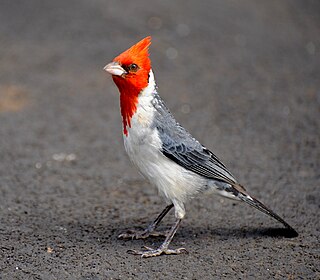
The red-crested cardinal is a passerine bird in the tanager family Thraupidae. Notwithstanding its similar name, this bird is not closely related to the true cardinal family Cardinalidae. It is sometimes known as the Brazilian cardinal.

The Tahiti monarch, or Tahiti flycatcher, is a rare species of bird in the monarch flycatcher family. It is endemic to Tahiti in French Polynesia. There are between 25 and 100 individuals remaining with an increasing population trend.

Brucea is a genus of plant in the family Simaroubaceae. It is named for the Scottish scholar and explorer James Bruce.

Zapornia is a genus of birds in the rail family Rallidae.




















